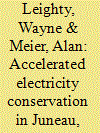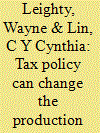|
|
|
Sort Order |
|
|
|
Items / Page
|
|
|
|
|
|
|
| Srl | Item |
| 1 |
ID:
104884


|
|
|
|
|
| Publication |
2011.
|
| Summary/Abstract |
An avalanche destroyed the main hydroelectric transmission line to Juneau, Alaska in April, 2008. Diesel-generated electricity was substituted, causing electricity prices to increase 500% for 45 days. Electricity demand fell by 25% during the supply disruption. Most of the reduction occurred before the higher rates were implemented. Some conservation - about 8% of historic consumption - persisted after the transmission line was repaired and prices returned to normal. Consumers reduced energy use through a combination of new habits and technical improvements. A survey of residential consumers indicated that the average household undertook 10 conservation actions, with major changes in lighting, space heating, fuel switching, and water and appliance use. We propose a method for prioritizing conservation actions for promotion according to their impact in electricity savings (as a function of popularity, effectiveness, and persistence) and a dynamic framework for electricity use before, during, and after a supply disruption (i.e., both the magnitude and rates of change in electricity conservation).
|
|
|
|
|
|
|
|
|
|
|
|
|
|
|
|
| 2 |
ID:
112290


|
|
|
|
|
| Publication |
2012.
|
| Summary/Abstract |
California's target for reducing economy-wide greenhouse gas (GHG) emissions is 80% below 1990 levels by 2050. We develop transition scenarios for meeting this goal in California's transportation sector, with focus on light-duty vehicles (LDVs). We explore four questions: (1) what options are available to reduce transportation sector GHG emissions 80% below 1990 levels by 2050; (2) how rapidly would transitions in LDV markets, fuels, and travel behaviors need to occur over the next 40 years; (3) how do intermediate policy goals relate to different transition pathways; (4) how would rates of technological change and market adoption between 2010 and 2050 impact cumulative GHG emissions?
We develop four LDV transition scenarios to meet the 80in50 target through a combination of travel demand reduction, fuel economy improvements, and low-carbon fuel supply, subject to restrictions on trajectories of technological change, potential market adoption of new vehicles and fuels, and resource availability.
These scenarios exhibit several common themes: electrification of LDVs, rapid improvements in vehicle efficiency, and future fuels with less than half the carbon intensity of current gasoline and diesel. Availability of low-carbon biofuels and the level of travel demand reduction are "swing factors" that influence the degree of LDV electrification required.
|
|
|
|
|
|
|
|
|
|
|
|
|
|
|
|
| 3 |
ID:
111381


|
|
|
|
|
| Publication |
2012.
|
| Summary/Abstract |
We model the economically optimal dynamic oil production decisions for seven production units (fields) on Alaska's North Slope. We use adjustment cost and discount rate to calibrate the model against historical production data, and use the calibrated model to simulate the impact of tax policy on production rate. We construct field-specific cost functions from average cost data and an estimated inverse production function, which incorporates engineering aspects of oil production into our economic modeling. Producers appear to have approximated dynamic optimality. Consistent with prior research, we find that changing the tax rate alone does not change the economically optimal oil production path, except for marginal fields that may cease production. Contrary to prior research, we find that the structure of tax policy can be designed to affect the economically optimal production path, but at a cost in net social benefit.
|
|
|
|
|
|
|
|
|
|
|
|
|
|
|
|
|
|
|
|
|